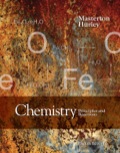
Concept explainers
There is a buffer system in blood
(a) Calculate the
(b) What percentage of the
(c) What percentage of the
(a)
Interpretation:
The ratio
Concept introduction:
Henderson-Hasselbalch equation is an equation useful to determine the pH of any solution when any acid’s aqueous solution is related to its acid dissociation constant.
Buffer equation is considered as an equation when ionization of a weak acid in the water occurs resulted into the hydronium ion and the conjugate base of that acid.
Answer to Problem 36QAP
The ratio
Explanation of Solution
For
For acid-dissociation constant of the given
For
Now, we need to determine the concentration of
In equation (1), we are substituting the value of
(b)
Interpretation:
The percentage
Concept introduction:
Henderson-Hasselbalch equation is an equation useful to determine the pH of any solution when any acid’s aqueous solution is related to its acid dissociation constant.
Buffer equation is considered as an equation when ionization of a weak acid in the water occurs resulted in the hydronium ion and the conjugate base of that acid.
Answer to Problem 36QAP
Explanation of Solution
The pH of the buffer system as 6.80and the ratio of the concentration of
Now, let us take the concentration of
We have the dissociation equation of
As per the Henderson-Hasselbalch equation,
Now, the percentage of
(c)
Interpretation:
The percentage
Concept introduction:
Henderson-Hasselbalch equation is an equation useful to determine the pH of any solution when any acid’s aqueous solution is related to its acid dissociation constant.
Buffer equation is considered as an equation when ionization of a weak acid in the water occurs resulted in the hydronium ion and the conjugated base of that acid.
Answer to Problem 36QAP
Explanation of Solution
We have the pH of the buffer system as 7.80 and the ratio of the concentration of
Now, let us take the concentration of
We have the dissociation equation of
As per the Henderson-Hasselbalch equation,
Now, the percentage of
Want to see more full solutions like this?
Chapter 14 Solutions
EBK CHEMISTRY: PRINCIPLES AND REACTIONS
- At a metal-solution interface, an electron is exchanged, and the symmetry factor beta < 0.5 is found in the Butler-Volmer equation. What does this indicate?arrow_forwardTopic: Photochemistry and Photophysics of Supramoleculesarrow_forwardTopic: Photochemistry and Photophysics of Supramoleculesarrow_forward
- How to name hydrocarbonsarrow_forwardPlease do these questions within the SCH4U course please with full steps since I am still unsure how to format my answers! Thank you so much.arrow_forwardWhen two solutions, one of 0.1 M KCl (I) and the other of 0.1 M MCl (II), are brought into contact by a membrane. The cation M cannot cross the membrane. At equilibrium, x moles of K+ will have passed from solution (I) to (II). To maintain the neutrality of the two solutions, x moles of Cl- will also have to pass from I to II. Explain this equality: (0.1 - x)/x = (0.1 + x)/(0.1 - x)arrow_forward
- Calculate the variation in the potential of the Pt/MnO4-, Mn2+ pair with pH, indicating the value of the standard potential. Data: E0 = 1.12.arrow_forwardGiven the cell: Pt l H2(g) l dis X:KCl (sat) l Hg2Cl2(s) l Hg l Pt. Calculate the emf of the cell as a function of pH.arrow_forwardThe decimolar calomel electrode has a potential of 0.3335 V at 25°C compared to the standard hydrogen electrode. If the standard reduction potential of Hg22+ is 0.7973 V and the solubility product of Hg2Cl2 is 1.2x 10-18, find the activity of the chlorine ion at this electrode.Data: R = 8.314 J K-1 mol-1, F = 96485 C mol-1, T = 298.15 K.arrow_forward
 Chemistry: The Molecular ScienceChemistryISBN:9781285199047Author:John W. Moore, Conrad L. StanitskiPublisher:Cengage Learning
Chemistry: The Molecular ScienceChemistryISBN:9781285199047Author:John W. Moore, Conrad L. StanitskiPublisher:Cengage Learning ChemistryChemistryISBN:9781305957404Author:Steven S. Zumdahl, Susan A. Zumdahl, Donald J. DeCostePublisher:Cengage Learning
ChemistryChemistryISBN:9781305957404Author:Steven S. Zumdahl, Susan A. Zumdahl, Donald J. DeCostePublisher:Cengage Learning Chemistry: An Atoms First ApproachChemistryISBN:9781305079243Author:Steven S. Zumdahl, Susan A. ZumdahlPublisher:Cengage Learning
Chemistry: An Atoms First ApproachChemistryISBN:9781305079243Author:Steven S. Zumdahl, Susan A. ZumdahlPublisher:Cengage Learning
 General Chemistry - Standalone book (MindTap Cour...ChemistryISBN:9781305580343Author:Steven D. Gammon, Ebbing, Darrell Ebbing, Steven D., Darrell; Gammon, Darrell Ebbing; Steven D. Gammon, Darrell D.; Gammon, Ebbing; Steven D. Gammon; DarrellPublisher:Cengage Learning
General Chemistry - Standalone book (MindTap Cour...ChemistryISBN:9781305580343Author:Steven D. Gammon, Ebbing, Darrell Ebbing, Steven D., Darrell; Gammon, Darrell Ebbing; Steven D. Gammon, Darrell D.; Gammon, Ebbing; Steven D. Gammon; DarrellPublisher:Cengage Learning Introduction to General, Organic and BiochemistryChemistryISBN:9781285869759Author:Frederick A. Bettelheim, William H. Brown, Mary K. Campbell, Shawn O. Farrell, Omar TorresPublisher:Cengage Learning
Introduction to General, Organic and BiochemistryChemistryISBN:9781285869759Author:Frederick A. Bettelheim, William H. Brown, Mary K. Campbell, Shawn O. Farrell, Omar TorresPublisher:Cengage Learning





